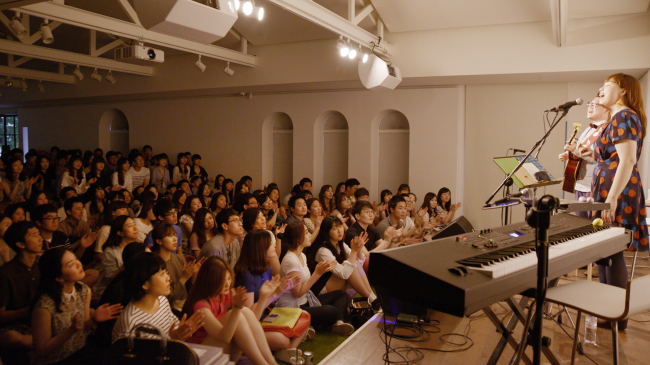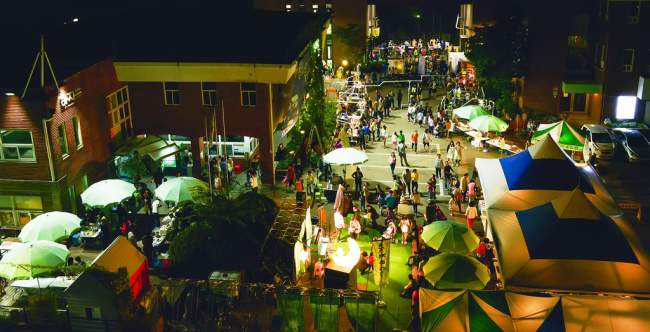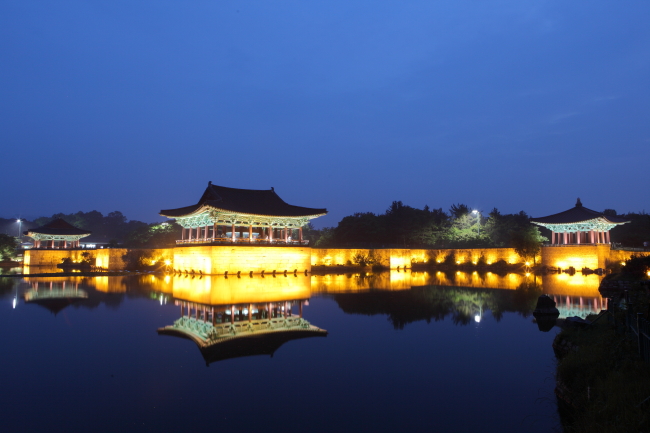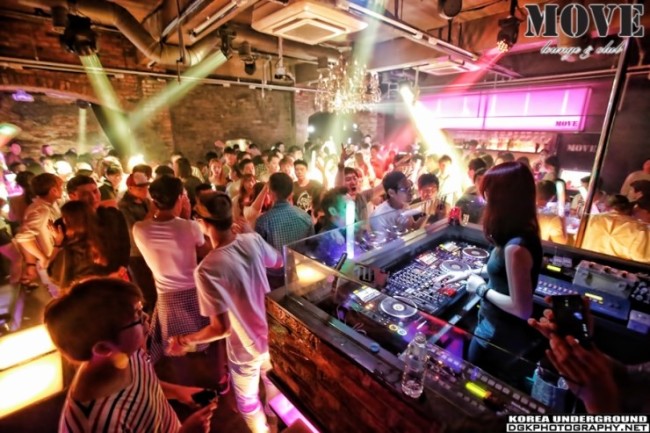[Weekender] Guide to Korean nightlife
From art galleries to food markets, Seoul offers ways to have fun while staying sober
By Claire LeePublished : July 4, 2014 - 21:36
While South Korea is known for its culture of binge drinking, the country also offers a lot of ways to have fun while staying sober.
When they are not hitting the pubs and karaoke bars that stay open until sunrise, some Koreans choose to watch films in 24-hour cinemas, check out evening art exhibitions or enjoy bindaetteok ― Korean mung bean pancakes ― at a night food market.
Here are some of the ways to have fun in Korea at night, from movies to the dance club scene in Itaewon.
Classy
Who says art exhibitions are just for the daytime? Seoul’s major art galleries are open until late at night on certain days, offering visitors a chance to enjoy the shows even after a long day at work.
When they are not hitting the pubs and karaoke bars that stay open until sunrise, some Koreans choose to watch films in 24-hour cinemas, check out evening art exhibitions or enjoy bindaetteok ― Korean mung bean pancakes ― at a night food market.
Here are some of the ways to have fun in Korea at night, from movies to the dance club scene in Itaewon.
Classy
Who says art exhibitions are just for the daytime? Seoul’s major art galleries are open until late at night on certain days, offering visitors a chance to enjoy the shows even after a long day at work.

The Seoul Museum of Art, a museum in central Seoul behind the picturesque Deoksugung Palace, stays open until 10 p.m. on the first and third Tuesday of each month.
The building was first constructed in 1927 to house the Supreme Court during the Japanese colonial period, but was later restored and turned into today’s museum.
“We have been doing this since 2012,” said curator Byun Ji-hye from the museum.
“We found that many working professionals in the city wanted to visit the museum after they finish work, but couldn’t because of their working hours. The purpose is to let these people enjoy art without having to worry about getting off work early and travel time. We get a lot of couples who are on dates, too.”
Among the exhibitions currently on show is “Malfunction Library,” which features works by Korean artists in their 30s and 40s who were inspired by today’s information-obsessed culture.
Among them, artist Kim Kyoung-ho, who has worked at the Korean bureau of Iranian Press TV, presents two versions of news footage. One is the original he filmed, and the other is the edited version that was broadcast.
Also in the show is “Universal Studio Seoul,” which features works by 13 Seoul-based artists from overseas, including Australian artist Emil Goh, who died in Korea in 2009.
Another is Kondo Yukako, who is married to a Korean and depicts her life here as a member of a Korean family in her works.
“It is just a nice way of ending your day,” said Kim Eun-hyung, an office worker in her 20s who visited the museum after 8 p.m.
“I actually dragged myself (to the museum) that day, because I was rather tired after work, but it was worth it. I felt energized after the exhibitions.”
Aside from SeMA, the National Museum of Modern and Contemporary Art in Samcheong-dong, central Seoul, also stays open until 9 p.m. every Wednesday and Saturday.
For more information on SeMA, visit sema.seoul.go.kr. For information about MMCA, visit www.mmca.go.kr.
Delicious
As dusk gathers on Friday night, Gwangjang Market’s food alley is awash with hundreds of people seeking wallet-friendly, authentic treats in a friendly atmosphere.
Koreans of all ages ― mostly students and office workers ― queue up to grab a seat in the market’s signature “pancake” restaurants or sit at one of 200 food stalls running through the center of the covered alley, clinking glasses and rubbing shoulders.
Some of the market’s specialties are “drug” kimbap (rice roll), given its name due to its addictive taste; arm-sized “king” sundae (blood sausage); and crispy nokdu bindaetteok (mung bean pancakes), according to Sim Seo-woon-yeo, who has run a second-generation food stall called Kyungtae’s House for the past three decades.
Jun Jeff and his girlfriend visit the market to taste some of the specialties.
“All the foods here are affordable and delicious,” Jun told The Korea Herald while pouring soju into a glass and handing it to his girlfriend.
Most of the eateries at the food alley offer their food for a fixed price, with “drug” kimbap at 2,500 won ($2.50), “king” blood sausage at 6,000 won and mung bean pancake at 5,000 won to 8,000 won.
But there is another reason the couple hangs out at the market.
“It is quite romantic for us to sit close to total strangers and even talk to them over food and drinks,” Jun said.
Gwangjang Market’s food bazaar is situated near Jongno 5-ga Subway Station’s Exit 8. You can easily access Cheonggyecheon Stream, right next to the market, to walk off your meal. The market is open from 9 a.m. to 11 p.m. every day.
Affordable
One of the most affordable ways to escape the summer heat at night is to hit a movie theater. CGV Gangnam operates 24 hours a day, allowing moviegoers to see a film anytime regardless of their schedule.
The theater screens films as frequently as 10 times a day, from 6:30 a.m. to 5 a.m. the next day.
Currently playing in the theater are Michael Bay’s sci-fi action film “Transformers: Age of Extinction,” Tom Cruise’s latest blockbuster “Edge of Tomorrow” and “The Divine Move,” starring Jung Woo-sung.
Tickets for screenings that take place between midnight and 10 a.m. are 8,000 won, while daytime screenings cost 9,000 won to 10,000 won.
Meanwhile, in Yeongdeungpo-gu, southwest Seoul, a special night market is being held once a month until October.
The unique, community-centered market offers handmade, environmentally friendly products at affordable prices, including soap, candles and even jewelry. Many of the items on sale are created by local people in their own homes.

Titled “Yeongdeungpo Dalsijang” (Yeongdeungpo Moon Market), the market also holds a special arts and crafts workshop for children, and runs a separate food market featuring local dishes such as handmade tea, tteokbokki (soft rice cake with sweet red chili sauce), and organic vegetables. The event will be complemented with a performance by local indie bands.
The market runs from 5 p.m. to 9 p.m. at Haja Center in Yeongdeungpo-gu, Seoul, on July 25, Aug. 29, Sept. 26 and Oct. 31. For more information, call (02) 2677-9200.

Korea also has a number of traditional sites famous for their night views nationwide. Some of the sites the Korea Tourism Organization recommends include Anapji, an artificial pond in Gyeongju, North Gyeongsang Province, constructed in 674 and the Fortress Wall of Seoul, which was built in 1937 as protection from invaders.
Wild
On the last Saturday in June, dance clubs in Itaewon were flooded with those who wanted to bask in the invigorating ambience.
Club Move, which opened in 2012, was one of them.
While looming speakers thundered with electronic dance music, a sea of guys in dress shirts, mostly in their 20s and 30s, were crammed around a dance floor watching ladies in glitzy dresses and high heels pole dancing.
“In this club, I can fully enjoy myself without having to care about what others think of me,” Yoon Hye-soo, 26, told The Korea Herald, queueing up with a friend to enter the club.

Taking her identification card and 10,000 won, the cover fee for the club, out of her purse, Yoon also talked about the main difference among three trendy club areas in Seoul ― Gangnam, Hongdae and Itaewon.
“I don’t like clubbing in Gangnam because it is too expensive, and you can only find young clubbers in Hongdae. So it leaves me no option but Itaewon,” the office worker said.
Stephanie Kovanda, a first-time clubber in Korea, agrees that Itaewon is where she can enjoy Seoul’s bustling nightlife.
“I was impressed that clubs here stay open later than many in the U.S. I can even have a drink while waiting in line for the club. It is a good spot for a fun night out,” the 27-year-old U.S. citizen said while stepping out of Move.
After midnight, the club charges women 10,000 won and men 15,000 won, which includes one free drink. Most cocktails and beers range in price from 8,000 won to 12,000 won. It is located near Itaewon Subway Station’s Exit 3 and is open from 10 p.m. to 6 a.m.
By Claire Lee and Ock Hyun-ju
(dyc@heraldcorp.com) (laeticia.ock@heraldcorp.com)


















![[Today’s K-pop] Treasure to publish magazine for debut anniversary](http://res.heraldm.com/phpwas/restmb_idxmake.php?idx=642&simg=/content/image/2024/07/26/20240726050551_0.jpg&u=)